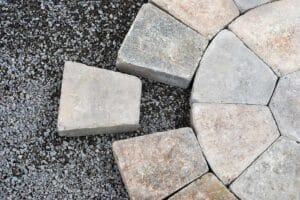
Ideas for Modern Concrete Driveways
Upgrading your concrete driveway can transform the overall look of your home and improve its curb appeal, similarly to a beautiful piece of modern art in an entryway. With creative techniques, you can make your concrete driveway a contemporary art form. This can be a cost-effective solution, as simple finishes and understated colors are generally more affordable than elaborate stamped concrete designs.
MODERN CONCRETE DRIVEWAY DESIGN TIPS
- To achieve a less rustic look, select large tiles or checkerboard patterns instead of stamped stone
- Consider using a straightforward color palette that features white, gray, or charcoal hues. You may also include some brighter accent colors to create visual interest
- To create a modern look, consider using seamless texture skins or broom finishes to add a slight texture to concrete surfaces
- To create a visually appealing design, use large rectangular, square, or diamond-shaped patterns with narrow strips of stone or grass in between
- To ensure your modern concrete driveway looks its best, make sure it complements the color scheme and environment of your home. While decorative concrete can be eye-catching, it should not be overwhelming
Channel Your Inner Zen
This modern driveway has rectangular concrete slabs that are separated by 6-inch-wide channels of decorative stone. The hardscape blends in with the surrounding landscape by incorporating pockets of greenery, and this gives a Zen-like flair to the whole arrangement.
Expose the Aggregate
An exposed aggregate finish is achieved by laying concrete and removing the top layer of cement paste to reveal colored decorative aggregate. This creates a modern and aesthetically pleasing surface resembling a gravel driveway but with increased durability and slip resistance.
Choose a Seamless Texture
Seamless stamps, also known as texture skins, add a stone-like texture to concrete without having any noticeable design. This makes the driveway appear like a single piece of stone. By using seamless patterns as a base, you can enhance the texture with customized colors or hand-tooled joints, which will match the overall style of your house. Additionally, using seamless stamps reduces the installation time compared to patterned stamps, ultimately lowering the cost.
Create Large-Scale Tile
To make a concrete driveway look like an elegant outdoor floor, you can sawcut an oversized tile pattern and use the joints as fake grout lines. Then, apply a light spray-textured coating to the concrete for a skid-resistant surface that looks like a classic rock-salt finish.
Add Circular Sawcuts
Circular saw cuts on a concrete driveway can create a striking effect without requiring any additional decorations. This design creates an interesting juxtaposition with the rectangular shapes of the home’s architecture while also achieving geometric harmony.
Let It Grow
The elegant pattern of this landscape is created by large slabs of light-colored concrete with strips of grass in between them. The grass helps control cracking naturally and also helps in improving drainage by absorbing water runoff. The design gives a natural blend into the surrounding greenery.
Add Subtle Interest
You can enhance the appearance of gray concrete by using concrete stains and sealer to add interest and artistry. The modern driveway in the picture is a good example, as the subtle color enhancement matches the gray tones on the second-story cladding of the house. Additionally, the grid of control joints on the driveway complements the grid on the contemporary garage door.
Be Swept Away
To add texture and contrast to plain concrete, one easy way is to use a broom finish. This creates fine lines on the surface. Adding joint lines with a smooth finish around the brushed concrete creates a nice picture frame effect.
Give It a Swirl
You can use a hand trowel to create a swirled finish as a decorative pattern on a concrete driveway. The finish can be coarse, medium, or smooth depending on the tool used to create the pattern. Coarser textures can be achieved using wood floats, while aluminum floats or steel trowels can be used for medium or smooth finishes.



